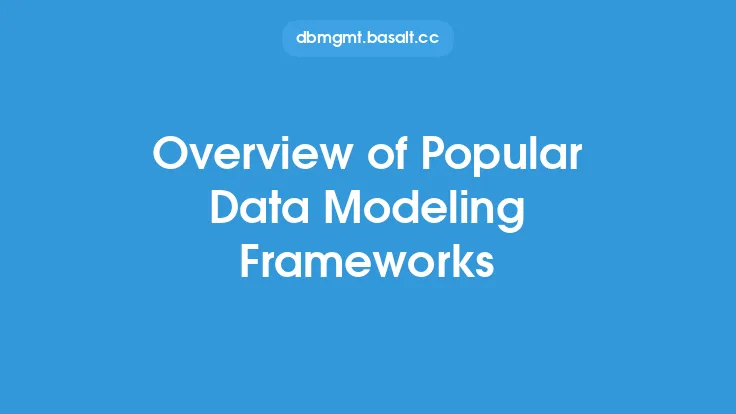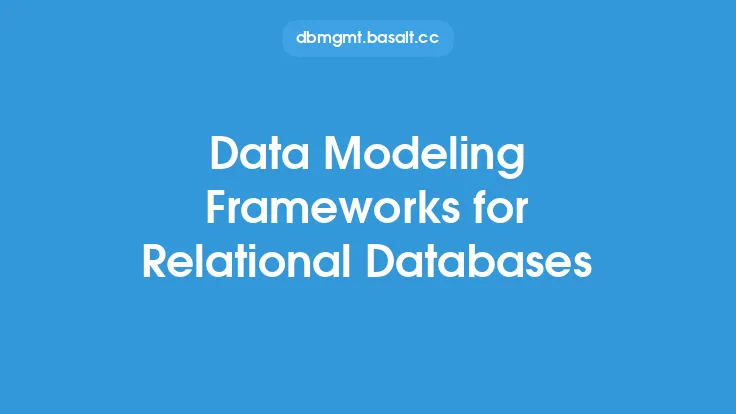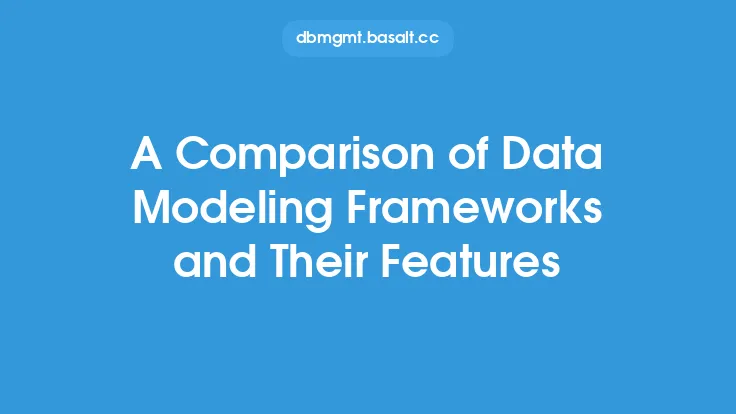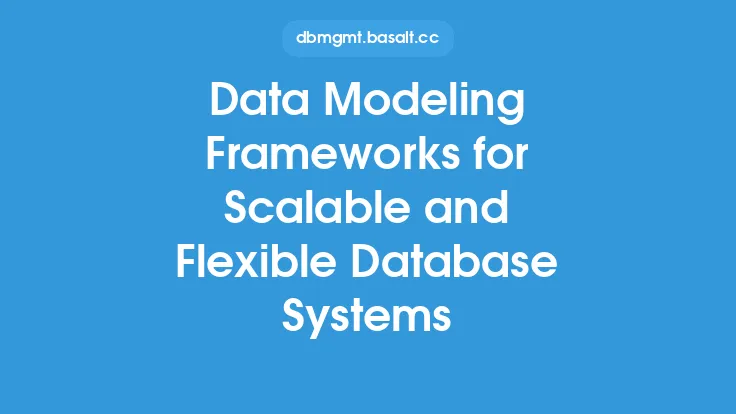NoSQL databases have become increasingly popular in recent years due to their ability to handle large amounts of unstructured and semi-structured data. As a result, the need for effective NoSQL data modeling frameworks has grown. A NoSQL data modeling framework is a set of guidelines, principles, and tools used to design and implement a NoSQL database. In this article, we will delve into the world of NoSQL data modeling frameworks, exploring their importance, key characteristics, and popular frameworks.
Importance of NoSQL Data Modeling Frameworks
NoSQL data modeling frameworks are crucial for designing and implementing scalable, flexible, and high-performance NoSQL databases. A well-designed NoSQL database can improve data retrieval and storage efficiency, reduce data redundancy, and enhance data consistency. NoSQL data modeling frameworks help developers and database administrators to create a robust and maintainable database architecture that meets the requirements of their application. They provide a structured approach to data modeling, ensuring that the database is optimized for performance, scalability, and data integrity.
Key Characteristics of NoSQL Data Modeling Frameworks
NoSQL data modeling frameworks typically have several key characteristics that distinguish them from traditional relational database modeling frameworks. Some of these characteristics include:
- Schema-less or dynamic schema: NoSQL databases often have a flexible or dynamic schema, which allows for changes to the data structure without requiring a predefined schema.
- Denormalization: NoSQL databases often use denormalization techniques to improve performance and reduce the need for joins.
- Data replication: NoSQL databases often use data replication to ensure high availability and improve performance.
- Distributed data storage: NoSQL databases often use distributed data storage to scale horizontally and improve performance.
- Support for unstructured and semi-structured data: NoSQL databases often support unstructured and semi-structured data, such as documents, graphs, and key-value pairs.
Popular NoSQL Data Modeling Frameworks
There are several popular NoSQL data modeling frameworks available, each with its own strengths and weaknesses. Some of the most popular frameworks include:
- MongoDB Data Modeling: MongoDB provides a data modeling framework that allows developers to design and implement scalable and high-performance databases.
- Cassandra Data Modeling: Cassandra provides a data modeling framework that allows developers to design and implement scalable and high-performance databases.
- Neo4j Data Modeling: Neo4j provides a data modeling framework that allows developers to design and implement graph databases.
- RavenDB Data Modeling: RavenDB provides a data modeling framework that allows developers to design and implement document-oriented databases.
- Amazon DynamoDB Data Modeling: Amazon DynamoDB provides a data modeling framework that allows developers to design and implement fast, fully managed, and scalable databases.
Data Modeling Techniques for NoSQL Databases
NoSQL data modeling frameworks often employ different data modeling techniques than traditional relational database modeling frameworks. Some common data modeling techniques used in NoSQL databases include:
- Document-oriented data modeling: This technique involves storing data in self-describing documents, such as JSON or XML.
- Graph data modeling: This technique involves storing data as nodes and edges in a graph structure.
- Key-value data modeling: This technique involves storing data as a collection of key-value pairs.
- Column-family data modeling: This technique involves storing data in columns instead of rows, which can improve performance and reduce storage requirements.
Best Practices for NoSQL Data Modeling
To get the most out of a NoSQL data modeling framework, it's essential to follow best practices for data modeling. Some best practices include:
- Understand the data: Before designing a NoSQL database, it's essential to understand the data and the requirements of the application.
- Choose the right data model: Different NoSQL databases use different data models, so it's essential to choose the right data model for the application.
- Denormalize data: Denormalization can improve performance and reduce the need for joins.
- Use data replication: Data replication can ensure high availability and improve performance.
- Monitor and optimize: Monitor the database performance and optimize the data model as needed.
Challenges and Limitations of NoSQL Data Modeling Frameworks
While NoSQL data modeling frameworks offer many benefits, they also have some challenges and limitations. Some of the challenges and limitations include:
- Lack of standardization: NoSQL databases often have different data models and query languages, which can make it difficult to switch between databases.
- Limited support for transactions: NoSQL databases often have limited support for transactions, which can make it difficult to ensure data consistency.
- Limited support for querying: NoSQL databases often have limited support for querying, which can make it difficult to retrieve data.
- Scalability and performance: NoSQL databases can be challenging to scale and optimize for performance.
Future of NoSQL Data Modeling Frameworks
The future of NoSQL data modeling frameworks is exciting and rapidly evolving. As NoSQL databases continue to grow in popularity, we can expect to see new and innovative data modeling frameworks emerge. Some of the trends that are likely to shape the future of NoSQL data modeling frameworks include:
- Increased use of artificial intelligence and machine learning: AI and ML can be used to improve data modeling and optimize database performance.
- Increased use of cloud-based databases: Cloud-based databases are becoming increasingly popular, and NoSQL data modeling frameworks will need to adapt to this trend.
- Increased focus on data consistency and integrity: As NoSQL databases become more widely used, there will be an increased focus on ensuring data consistency and integrity.
- Increased use of graph databases: Graph databases are becoming increasingly popular, and NoSQL data modeling frameworks will need to adapt to this trend.





